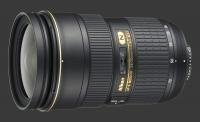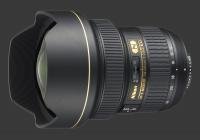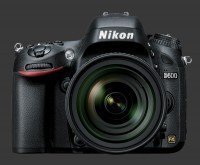Nikon D600 Review
Nikon D600 Performance - How well does it take pictures?
Ultimately, it is the image quality that makes a camera worth buying. For a digital SLR, image quality greatly depends on the lens used. While color, noise, contrast and exposure are properties of the camera, distortion, vignetting and chromatic aberrations are properties of the lens. Sharpness depends on the weakest link. So, the camera cannot capture more details than the lens lets through. Conversely, a lens can transmit a greater amount of details than the sensor can capture.
A high-resolution full-fame DSLR like the Nikon D600 is particularly demanding on lenses and it cannot show its highest image quality without a suitably sharp lens. Compared to a DX DSLR, an FX model does not really resolve finer details but its greater field-of-view uses the weakest outer-portions of a lens. After trying several lenses, both the Nikkor AF-S 24-70mm F/2.8 IF-ED
Nikkor AF-S 24-70mm F/2.8 IF-ED and the Nikkor AF-S 14-24mm F/2.8G IF-ED
Nikkor AF-S 14-24mm F/2.8G IF-ED were up to the challenge. These lenses are among the very best and well worth their price.

The Nikon D600 produces extremely clean images with less noise than any DSLR camera. This performance holds extremely well at high ISO too and even DxOMark gave it their highest Low-Light score ever. Images from the D600 are virtually noise-free until ISO 1600 inclusively. ISO 3200 shows a slight amount of noise but still not enough to reduce print sizes.
The highest standard sensitivity of 6400 gets a little more noise which is visible at 100% but does not show in medium-sized prints, say 12" x 8". In good light, the same can be said of ISO 12800 which remains completely usable even in low-light for medium prints. The maximum expanded ISO of 25600 displays obvious color-noise. However, considering a resolution of 24 megapixels, even that sensitivity makes very nice prints at typical sizes.
Image sharpness is highly dependent on the lens which is the most likely cause of soft images on the D600. Keep in mind that most lenses need to be stopped down 1 or 2 stops from their maximum apertures and the D600 has a greater diffraction limit than DX cameras due to its larger pixels. One may stop down to F/16 without issues. Even at the optimal aperture, this DSLR never shows critical sharpness due to its anti-alias filter.
In-camera sharpening is set on a 10-point scale, with the default being overly soft. Setting Sharpness to 5 delivers the maximum sharpness without artifacts but leaves images looking very slight soft when seen at 100%. One can always apply their own sharpening if shooting RAW.
The Nikon Matrix metering of the D600 is generally good and consistent with standard lenses. It often chooses conservative exposures and rarely blows out highlights. On the flip side, it does produce more under-exposure than average. The system seems more influenced by the center of the frame than ideal which may cause over-exposure when only a small portion of sky is showing for example. The D600 supports a customizable metering offset of ±1 EV in 1/6 EV increments that can be set independently for each metering mode. This is great since Spot and Average metering work exactly as expected.
Image parameters provide a good amount of fine-grain flexibility in terms of color rendition. There are six picture styles offering various degrees of realism. Vivid is not as extremely overdone as on previous Nikon models but still visibly over-saturated. The Standard and Natural styles are closest to reality with natural colors somewhere in between. The most realistic results were obtained in Standard style with Saturation at -1 and Hue at +1.
Automatic white-balance is very good and cancels out color-casts under most conditions. The two Auto settings vary in how they deal with the warm color-cast typical of tungsten lighting. One setting tries to correct it while the other does not. This is much improved from previous generations.

Dynamic-range is awesome. Given the full-frame CMOS sensor and its moderate resolution for a DSLR, this is entirely expected. The latitude of the D600 can only be seen in RAW images since its over 14 stops of dynamic-range cannot be stored in a JPEG image without gaps. With larger pixels than the D800, it can actually surpass it. DxOMark normalizes results with respect to resolution which is why it gives a slight edge to the D800 and the D800E but on a per-pixel basis, the D600 cannot be beaten yet.
The Nikon D600 is a very fast and responsive camera. It speed is characterized by the following performance numbers:
- Power On: Instant. Excellent.
- Power Off: Just under ½s. Awesome.
- Autofocus: As little as ¼s, up to 1s with a slow lens in low-light. Generally good.
- Focus Confirm: Nearly instant for both autofocus and manual focus. Excellent.
- Shutter-lag: Instant followed by extremely short black-out. Extremely good.
- Shot-to-Shot Speed: About ¼. Class-leading.
- Instant Review: About ½s. Good.
- Playback Mode: ½s. Good.
- Shooting Mode: Instant. Great.
This camera features automatic distortion correction based on pre-programmed lens data. Due to the nature of optical distortion, parts of the captured image get cropped, making precise framing impossible. Enabling it also slows the D600 down by adding almost ½s to the Instant Review delay. Plus, It reduces buffer-depth for JPEG images by half. Distortion Correction has no impact on RAW files.
There is also an optional Vignetting Control feature which does not affect camera performance. Unfortunately, this one is not profile-based and simply applies the selected level of correction. Options are Off, Low, Normal and High. While vignetting is actually very easy correct in software without detriment to image quality, we cannot recommend using this feature. Vignetting varies by lens, focal-length and aperture, so it would be considerably too much work to keep adjusting Vignetting Control according for constantly changing parameters.

The 39-point autofocus system used on the D600 is generally fast. It does slow down in low-light, particularly at close focusing distance. Slow lenses also slow it down since they give less light for the AF system to work with. In continuous autofocus mode, the camera manages to keep up well with moving subjects in moderate to good light. This is a good performance but not as stellar as top-of-the-line full-frame DSLRs.
Battery-life is reasonable, achieving 900 shots-per-charge according to the CIPA standard. Keep in mind that, as usual, this number accounts for 50% flash use but not video recording and extra use of the rear LCD.
Nikon D600 Performance - How well does it shoot video?
The Nikon D600 is capable of recording full 1080p HD video at up to 30 FPS. Settings of 25 and 24 FPS are also available. Which one to use depends on the intended use. It can also record 720p HD video at up to 60 FPS which can be used to render action more smoothly. A 50 FPS rate is also available which is compatible with European standards. Recording 30, 25 or 24 FPS at 720p is also possible.
Video can be recorded with or without sound. The camera includes a built-in mono microphone with adjustable levels in 20 steps. Optionally, an external stereo sound source can be connected to the mini-jack. Nikon makes the ME-1 Stereo Microphone which attaches to the hot-shoe.
The Nikon D600 luckily features a dedicated video mode. It is activated by entering Live-View with the rotating switch set to Video. This is set independently of the exposure mode-dial position. Each time it is turned, the camera exists Video mode though. Conceptually, this means that full manual-controls are available but the D600 locks up most settings except in M mode. In A mode, the aperture has to be set before entering Video mode. ISO sensitivity is locked except for M mode. Videos can be recorded to either memory card.

The dedicated Video Record button starts recording with a short but noticeable delay of ½s. Pressing it again stops recording instantly. There are two focus modes when recording video:
- AF-S: Single-shot autofocus which is performed each time the shutter-release is pressed half-way. The focus-area can be moved anywhere in the frame using the 8-way controller. Manual focus is also available before and during filming using any lens with an M/A mode.
- AF-F: The camera focuses continuously at all times, before and during filming. This results in audible noise which can be captured by the built-in microphone. More importantly, it causes back-and-forth lens movement due to the nature of Contrast-Detect autofocus. Avoid this mode for videos intended to be of quality.
Four AF-areas options are available for video capture: Wide, Normal, Tracking and Face-Detect. The latter two are only available in AF-F focus-mode. Quality videos are normally produced in MF mode where none of these apply. If you must use AF for video, use AF-S with Normal area and perform autofocus at the least bothersome time with the focus-point positioned neatly on the desired subject. Remember that missed focus attempts will be seen in recorded video and disturb viewers.
Video quality from the Nikon D600 is reasonably good. Plenty of details are captured and movement is rendered smoothly. At high quality settings, videos show very little compression artifacts. Frames sometimes show moire when filming objects with fine patterns. There is also the appearance of mosquito noise in low-light. Both these artifacts are present in the first few seconds of the sample video. They can only be seen at maximum quality on a screen capable of displaying 1080p resolution tough.
Time-Lapse
This DSLR is the first to capture time-lapse video. It can do this in any mode but it only makes sense in Video mode because that is the only way to properly frame the time-lapse. Intervals between the start of exposures can be set between 1s and 10m, in 1s increments. The total time to capture the time-lapse can be set between 1m and 7h59m, in 1m increments. While setting these parameters, the camera shows the length of the video.
The manual says that time-lapse is not available in Video or Live-View mode. They also recommend checking framing in Video mode. However you can start time-lapse recording in Video mode while seeing the proper framing. The camera exits its mode when it starts the time-lapse, so the manual is not lying, just misleading.
Any exposure-mode can be used for the time-lapse and metering is performed for each frame. Focus is locked at the first frame though. Resulting images are scaled down and combined into a video of the selected quality. The top status display counts down the number of remaining minutes. The OK button can be used to interrupt the process and stores the time-lapse captured up to that point.
Time-lapse quality is excellent and surprisingly appears better than video. It could be that longer exposures for each frame smooth out images better or their might be other technical reasons. Nevertheless, this time-lapse feature is very welcome. Of course there is less flexibility than assembling a time-lapse by computer but it has a number of important advantages:
- Less Storage: Only the final video is stored. This avoid storing thousands of intermediate images.
- Video Aspect-Ratio: The typical way of showing a time-lapse is video. There is no need to recompose and crop frames later to match the aspect-ratio of video.
- Immediate Results: The D600 can play back the time-lapse a few seconds after completing its capture. This lets the photographer know if the desired results were achieved or not.
Check out the video page again for a sample time-lapse video.
Nikon D600 Conclusion
The Nikon D600 clearly surpasses expectations. This full-frame 24 megapixels DSLR delivers stunning image quality and a rich feature-set at a never-seen-before price. The D600 particularly excels in terms of image noise and dynamic range while delivering a solid performance in terms of white-balance, color accuracy and speed.
Nikon even managed to keep the most important professional features in this camera: a 100% coverage OVF, weather-sealed body, dual control-dials, dual axis digital-level and dual memory cards. The Nikon D600 also squeezes in a built-in flash next to its industry-standard hot-shoe.
The usability of this DSLR is good and even more so after the extensive customization it supports. There is a large number of external controls to provide direct access to most important functions. While video thankfully gets it own mode, there are a number of oddities with it and Live-View upon which it is based. The real bonus feature though is time-lapse video which is unique among DSLRs and immensely helpful.
Outside of those few quirks, the D600 has very few issues. Metering could stand to be more reliable but it rarely over-exposes. It is also more sensitive than usual to light entering the viewfinder. For vibration-free captures, a remote trigger is recommended given that Exposure Delay mode is only accessible via the menu system.
The Nikon D600 manages to deliver excellent results with the right lenses and it does so quickly and efficiently for the most part. For those going full-frame or upgrading from a previous model, this DSLR should be at the top of your list. Even at its price-point, there are very few features to miss on the D600. Plus, any remaining budget can be wisely invested in high-end Nikkor FX lenses to see the true potential of the Nikon D600.
 |
Please Support Neocamera
All information on Neocamera is provided free of charge yet running this website is a huge endeavor. Purchases made via affiliate links found throughout the site help keep it running and up-to-date. There is no additional cost to you, so please consider buying via these links to our affilates:
If you found any information on this site valuable and did not purchase via our affiliate links, please considering donating via PayPal:
Any amount will be greatly appreaciated. Thank you for your support!
Nikon D600 Highlights

Sensor-Size: 36 x 24mm

Actual size when viewed at 100 DPI
| 24 Megapixels DSLR | ISO 50-25600 |
| Nikon F Mount 1X FLM | Shutter 1/4000-30s |
| 100% Coverage Extra Large Viewfinder | Full manual controls, including Manual Focus |
| 2 Axis Digital Level | Custom white-balance with 2 axis fine-tuning |
| Weatherproof | Spot-Metering |
| Built-in Dust Reduction | Hot-Shoe |
| 5.5 FPS Drive, 57 Images | Stereo audio input |
| 1920x1080 @ 30 FPS Video Recording | Lithium-Ion Battery |
| 3.2" LCD 920K Pixels | Secure Digital Extended Capacity x 2 |
Updates
2025.01.18

Fujifilm GFX 2025 Lens Roundup
Lens Review roundup of Fujifilm GFX Medium-Format lenses. Quality, performance and handling of the GF20-35mm F/4R WR, GF30mm F/3.5 Tilt-Shift and the GF55mm F/1.7.
2024.11.18

Best 2024 Photography Gifts for Every Budget
Great gifts for photographers and photo enthusiasts selected for every budget among the best products of 2024.
2024.08.07

Eye Protection Tips for Professional Photographers
The four main considerations for professional photographers regarding eyewear.
2024.07.14

Fujifilm X100VI Review
Flagship fixed-lens compact digital camera with a 40 MP sensor and Image-Stabilization, a first for the series. Retro design featuring dual control-dials, plus direct ISO, Shutter-Speed and EC dials. Its hybrid viewfinder can switch between EVF and OVF mode.
2024.05.09

Fujifilm GFX100 II Review
Flagship 102 Megapixels Medium-Format Mirrorless Digital Camera with 8-Stop 5-Axis IBIS, 8 FPS Drive, 8K Video and 400 MP Super-Resolution capture in a weatherproof and freezeproof body with dual control-dials and dual memory-card slots.
2024.04.03

Fujifilm X-T5 Review
Newest Fujifilm flagship boasting a 40 MP APS-C sensor, 5-axis IBIS with 7-stop efficiency, 15 FPS continuous drive, 6.2K Video capture, dual control-dials and dual SDXC UHS-II slots in a sturdy weatherproof and freezeproof body.
2023.11.20

Best Digital Cameras of 2023
Find out which are the Best Digital Cameras of 2023. All the new Mirrorless Digital Cameras from entry-level to high-end professional.
2023.07.10

Fujifilm X-H2 Review
40 Megapixels APS-C Hybrid Mirrorless Digital Camera with 7-stop IBIS. Fastest shutter ever and 8K video capture. Large builtin EVF with 0.8X magnification and 5.8 MP, plus an Eye-Start Sensor. Packed with features and large number of controls in a weatherproof and freezeproof body.
2023.05.07

Sony FE 20-70mm F/4G Review
Review of the unique Sony FE 20-70mm F/4G lens. The optical zoom of this lens spans ultra-wide-angle and medium focal-length coverage, making it one of the most versatile Full-Frame lenses on the market.
2023.01.15

Huion Inspiroy Dial 2 Review
Review of the Huion Inspiroy Dial 2 tablet, a medium sized drawing surface with dual dials and customizable buttons. Connects via USB-C or Bluetooth 5.0 with Windows, Linux and Android support.
2022.12.08

How to Pack for a Photo Trip
Find out how to pack for a travel photography trip, carry your gear safely while meeting airline regulations.
2022.11.13

Best Digital Cameras of 2022
The best digital cameras of 2022. A short list of the most outstanding models in their respective categories. Choose one for yourself or as a gift.












